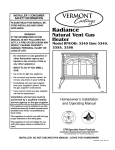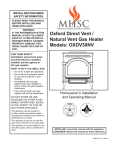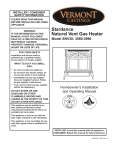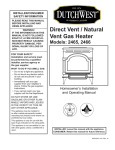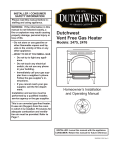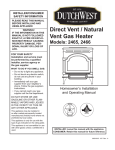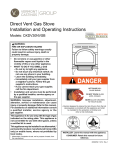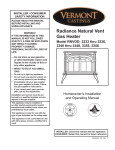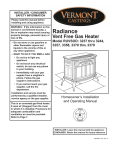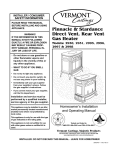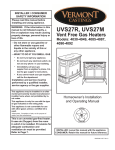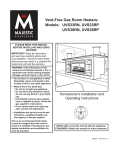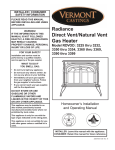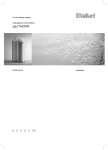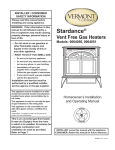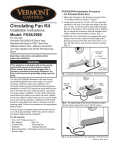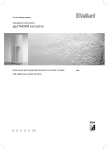Download DutchWest 2468 Operating instructions
Transcript
INSTALLER / CONSUMER SAFETY INFORMATION PLEASE READ THIS MANUAL BEFORE INSTALLING AND USING APPLIANCE. WARNING! IF THE INFORMATION IN THIS MANUAL IS NOT FOLLOWED EXACTLY, A FIRE OR EXPLOSION MAY RESULT CAUSING PROPERTY DAMAGE, PERSONAL INJURY OR LOSS OF LIFE. Dutchwest Natural Vent Gas Heater Models: 2467, 2468 FOR YOUR SAFETY Installation and service must be performed by a qualified installer, service agency or the gas suppler. WHAT TO DO IF YOU SMELL GAS: • Do not try to light any appliance. • Do not touch any electric switch; do not use any phone in your building. • Immediately call your gas supplier from your neighbor’s phone. Follow the gas supplier’s instructions. • If you cannot reach your gas supplier, call the fire department. DO NOT STORE OR USE GASOLINE OR OTHER FLAMMABLE VAPORS AND LIQUIDS IN THE VICINITY OF THIS OR ANY OTHER APPLIANCE. This appliance may be installed in an after market permanently located manufactured (mobile) home where not prohibited by local codes. Homeowner’s 2008 Installation Dutchwest and Operating Manual gas stove DE S I GN CE cover 6/03 CERTIFIED RTIFI E D This appliance is only for use with the type of gas indicated on the rating plate. This appliance is not convertible for use with other gases unless a certified kit is used. INSTALLATEUR : laissez ce manuel avec l’appareil. PROPRIÉTAIRE : conservez ce manuel pour consultation future. 30002008 4/07 Rev. 10 Dutchwest Natural Vent Gas Heater Table of Contents PLEASE READ THE INSTALLATION & OPERATING INSTRUCTIONS BEFORE USING APPLIANCE. Thank you and congratulations on your purchase of a Dutchwest stove. IMPORTANT: Read all instructions and warnings carefully before starting installation. Failure to follow these instructions may result in a possible fire hazard and will void the warranty. Installation & Operating Instructions ......................................................................................... 3 Stove Dimensions ............................................................................................................... 4 Clearance Requirements..................................................................................................... 5 Alcove Minimum Dimensions .............................................................................................. 5 Hearth Requirements .......................................................................................................... 5 Gas Specifications............................................................................................................... 6 Gas Inlet and Manifold Pressures ....................................................................................... 6 High Elevations ................................................................................................................... 6 Venting Requirements ......................................................................................................... 6 Vent Layout and Height Requirements................................................................................ 6 Passing Through a Combustible Wall or Ceiling ................................................................. 7 Venting Requirements ......................................................................................................... 7 Install the Optional Fan ....................................................................................................... 8 Venting System Assembly ................................................................................................... 9 Connect the Gas Supply Line............................................................................................ 10 Burner Information............................................................................................................. 11 Install ON/OFF Switch ....................................................................................................... 11 Thermostat Connection ..................................................................................................... 11 Install the Logset ............................................................................................................... 11 Install Stove Front ............................................................................................................. 12 Operation Your First Fire .................................................................................................................... 13 Pilot and Burner Inspection ............................................................................................... 13 Lighting and Operating Instructions................................................................................... 14 Troubleshooting ................................................................................................................. 15 Fuel Conversion Instructions ............................................................................................. 16 Maintenance Annual System Inspection ................................................................................................. 19 Logset and Burner Cleaning and Inspection ..................................................................... 19 Care of Cast Iron ............................................................................................................... 19 Cleaning the Glass ............................................................................................................ 19 Glass Replacement ........................................................................................................... 19 Gasket Replacement ......................................................................................................... 20 Inspect the Vent System Annually ..................................................................................... 20 Check the Gas Flame Regularly ....................................................................................... 20 2 30002008 Dutchwest Natural Vent Gas Heater Installation & Operating Instructions The Dutchwest Natural Vent Room Heater, Model Nos. 2467 and 2468, is a vented gas appliance listed to the ANSI standard Z21.88-2005 and CSA-2.33-2005 for Vented Room Heaters, and CSA 2.17-M91, Gas-Fired Appliances For Use at High Altitudes. The installation of the Dutchwest Natural Vent Room Heater must conform with local codes, or in the absence of local codes, with National Fuel Gas Code, ANSI Z223.1/NFPA 54 — latest edition and CSA B-149.1 Installation Code. (EXCEPTION: Do not derate this appliance for altitude. Maintain the manifold pressure at 3.5 inches w.c. for Natural Gas and 10 inches w.c. for LP gas at maximum input.) This appliance is only for use with the type of gas indicated on the rating plate. This appliance is not convertible for use with other gases unless a certified kit is used. Installation and replacement of gas piping, gas utilization equipment or accessories, and repair and servicing of equipment shall be performed only by a qualified agency, preferably NFI or WETT (Canada) certifieds. The term “qualified agency” means any individual, firm, corporation, or company that either in person or through a representative is engaged in and is responsible for (a) installation or replacement of gas piping, or (b), the connection, installation, repair, or servicing of equipment, who is experienced in such work, familiar with all precautions required, and has complied with all the requirements of the authority having jurisdiction. The Dutchwest Natural Vent Room Heater should be inspected before use and at least annually by a qualified service agency. It is imperative that control compartments, burners, and circulating air passageways of the appliance be kept clean. The Dutchwest Natural Vent Room Heater and its individual shutoff valve must be disconnected from the gas supply piping during any pressure testing of that system at test pressures in excess of 1/2 psig (3.5 kPa). The Dutchwest Natural Vent Room Heater must be isolated from the gas supply piping system by closing its individual manual shutoff valve during any pressure testing of the gas supply piping system at test pressures equal to or less than 1/2 psig. An accessible tap is located above the pilot/on-off knob for checking the inlet pressure. This appliance needs fresh air for safe operation and must be installed so there are provisions for adequate combustion and ventilation air. This appliance must be properly connected to a listed 4” (100mm) Type B venting system or to an approved masonry or factorybuilt chimney system. In Canada, a complete reline of Class A chimneys is required. This heater is equipped with a vent safety shutoff system. This appliance must be properly connected to a venting system. WARNING: Operation of this heater when not connected to a properly installed and maintained venting system or tampering with the vent safety shutoff system can result in carbon monoxide (CO) poisoning and possible death. This appliance is approved for bedroom installations in the U.S. and Canada. 30002008 This appliance may be installed in an aftermarket* manufactured (mobile) home, where not prohibited by state or local codes. The Dutchwest Natural Vent Room Heater, when installed, must be electrically grounded in accordance with local codes or, in the absence of local codes, with the National Electrical Code ANSI/ NFPA 70, (latest edition), or of the current Canadian Electrical Code C22.1. Due to high temperatures this appliance should be located out of traffic and away from furniture and draperies. WARNING: This appliance is hot while in operation. Keep children, clothing, and furniture away. Contact may cause burns or ignition of combustible materials. Children and adults should be alerted to the hazards of high surface temperatures and should stay away to avoid burns or clothing ignition. Young children should be carefully supervised when they are in the same room as the appliance. Clothing or other flammable materials should not be placed on or near the appliance. Any safety screen, glass or guard removed for servicing an appliance must be replaced prior to operating the appliance. The appliance area must be kept clear and free from combustible materials, gasoline, and other flammable vapors and liquids. The flow of combustion and ventilation air must not be obstructed. The installation must include adequate accessibility and clearance for servicing and proper operation. WARNING: Do not operate the Room Heater with the glass panel removed, cracked or broken. Replacement of the panel should be done by a licensed or qualified service person. Do not use this appliance if any part has been under water. Immediately call a qualified service technician to inspect the appliance and to replace any part of the control system and any gas control which has been under water. Do not burn wood, trash or any other material for which this appliance was not designed. This appliance is designed to burn either natural gas or propane only. This gas appliance must not be connected to a chimney flue serving a separate solid-fuel burning appliance. CAUTION: Label all wires prior to disconnection when servicing controls. Wiring errors can cause improper and dangerous operation. Verify proper operation after servicing. * Aftermarket: Completion of sale, nor for purpose of resale, from the manufacturer. Proposition 65 Warning: Fuels used in gas, woodburning or oil fired appliances, and the products of combustion of such fuels, contain chemicals known to the State of California to cause cancer, birth defects and other reproductive harm. California Health & Safety Code Sec. 25249.6 3 Dutchwest Natural Vent Gas Heater Dutchwest Natural Vent Gas Heater Dimensions See Page 5 for Flue Collar Centerline Dimensions. 6���" (172 mm) CL Valve Inlet 24���" (622 mm) 28���" (721 mm) C Valve 4���" L Inlet (111 mm) 12���" (318 mm) 23" (584 mm) 17" (419 mm) Fig. 1 Dutchwest dimensions. 2008 Dutchwest NV dimensions 6/23/03 4 30002008 Dutchwest Natural Vent Gas Heater Ceiling Clearances Clearance Requirements Minimum Clearances to Combustible Materials 45" (1140mm) Measure side clearances as shown in Figures 2 through 5 from the outer edge of the cast iron stove top. Measure rear clearances from the outermost surface of the sheet metal rear skirt. 72" (1829mm) The Dutchwest heater is approved for installation into an alcove constructed of combustible materials to the dimensions and clearances shown in Figure 5. The same clearances apply in a standard parallel installation. Parallel Installation: Minimum Clearance and Flue Centerline ST774 Fig. 4 Minimum ceiling clearance; minimum alcove height. Alcove Minimum ST774 Dimensions Dutchwest nv C Min. Clg Clrnc 6/03 djt C L C A D C L A A: 4” (102mm) B A: 5” (125mm) B: 4” (102mm) Pipe Centerlines ST128b C: 16” (406mm) D: 9¹⁄₄” (235mm) Stardance ST128c flue centerline Fig. 2 Parallel installation requirements. 9/28/00 djt Corner Installation: Minimum Clearance and Flue Centerline B C: 5” (125mm) B A A: 4” (102mm) B: 17” (432mm) Fig. 3 Corner installation requirements. ST129c Dutchwest corner specs 5/15/03 djt ST658 Fig. 5 The Dutchwest Natural Vent Stove is approved for installation into SNV alcoves built of combustible materials. alcove mins. 5/25/01 djt Hearth Requirements The Dutchwest Heater must be installed on rigid flooring. When the heater is installed directly on any combustible surface other than wood flooring, a metal or wood panel extending the full width and depth of the unit must be used as the hearth. There are no other hearth requirements. WARNING: A 30002008 B: 33” (838mm) ST775 Stove Clearances Stove Clearance Pipe Centerline A B ST129c • Always maintain required clearances (air spaces) to nearby combustibles to prevent fire hazard. Do not fill air spaces with insulation. All venting components must maintain a 1” (25 mm) clearance to combustible materials. Maintain a 6” (152 mm) clearance when using single wall pipe. • The gas appliance and vent system must be vented directly to the outside of the building and never be attached to a chimney serving a separate solid fuel or gas-burning appliance. • Refer to the manufacturer’s instructions included with the venting system for complete installation procedures. 5 Dutchwest Natural Vent Gas Heater Gas Specifications Model Fuel Gas Control Max. Input BTU/h 2467 2468 Nat Prop Millivolt Millivolt 28,000 28,000 Venting Requirements and Options Min. Input BTU/h 20,000 19,000 Weight: Fully assembled 350 lbs. Gas Inlet and Manifold Pressures Inlet Minimum Inlet Maximum Manifold Pressure Natural 5.5” w.c. 14” w.c. 3.5” w.c. LP (Propane) 11” w.c. 14” w.c. 10” w.c. Dutchwest Natural Vent Certified to: ANSI Z21.88-2005 / CSA Z2.33-2005 Vented Gas Fireplace Heaters The installation must conform with local codes or, in the absence of local codes, with the National Fuel Gas Code, ANSI Z223.1/NFPA 54 - latest edition. (EXCEPTION: Do not derate this appliance for altitude. Maintain the manifold pressure at 3.5” w.c. for Natural Gas and 10” w.c. for Propane.) High Elevations Input ratings are shown in BTU per hour and are certified without deration for elevations up to 4,500 feet (1,370m) above sea level. For elevations above 4,500 feet (1,370m) in USA, installations must be in accordance with the current ANSI Z223.1/NFPA 54 and/or local codes having jurisdiction. In Canada, please consult provincial and/or local authorities having jurisdiction for installations at elevations above 4,500 feet (1,370m). WARNING: Improper installation, adjustment, alteration, service or maintenance can cause injury or property damage. Refer to this manual for correct installation and operational procedures. For assistance or additional information consult a qualified installer, service agency, or the gas supplier. 6 The Dutchwest must be properly connected to a listed 4” (102 mm) Type B venting system or to an approved Class A masonry or factory-built chimney system. In Canada, a complete relining of Class A chimney systems is required. The Dutchwest Natural Vent stove will accept decorative 6” (150mm) stove pipe around the Type B venting system, for aesthetic purposes. Complete Type B vent systems are available from a number of manufacturers, and your dealer can usually supply one. Pipe sections from different makers are not interchangeable; do not mix pipe or vent sections from different makers. Follow the vent system manufacturer’s instructions. The vent system should conform to the specifications of the National Fuel Gas Code, latest edition. If connecting to a Class A chimney system, use 4” (102 mm) single wall or 4” Type B vent connector. Single wall vent connector requires a minimum 6” (152 mm) clearance to combustible surfaces. Exterior chimneys may be subject to flow reversal or condensation. To lessen these conditions, enclose Type B vents in an insulated chase, or reline exterior Class A chimneys. An approved pass-through device is always required, whether the vent system passes through a wall or a ceiling. Use a pass-through device from the same maker who supplies the venting system. Venting terminals shall not be recessed into a wall or siding. Vent Layout and Height Requirements Venting for a Dutchwest can rise vertically through the home, or can pass through an exterior wall and rise along the outside of the home. Some codes require that a Type B vent system rising on the outside of the home be enclosed in a chase. Check your local codes for requirements. The minimum vent system height for the Dutchwest Natural Vent Stove is 8’ (2.43 m), (Fig. 7) measured from the top of the stove. To determine the minimum height the vent system must extend through or past the roof, refer to the 1993 edition of the National Fuel Gas Code. 30002008 Dutchwest Natural Vent Gas Heater Passing Through a Combustible Wall or Ceiling Venting Requirements Complete the venting system installation according to the manufacturer’s instructions. Air Space as Required by Code Joists Ceiling Support 36 Vertical Run (in feet) (Measured from top of the unit before any elbow) An approved pass-through device is always required when a vent passes through a combustible wall or ceiling. Check with the maker of the vent system for the correct listed devices that are available. A listed passthrough device is required whether or not the installation includes decorative pipe around the Type B venting system. NOTE: It is essential to seal between the ceiling support (sometimes called a ‘firestop spacer’) and the decorative pipe, if installed, with a high-temperature silicone sealant. (Fig. 6) 34 A 32 30 28 26 24 22 20 18 16 14 12 10 8 6 4 2 1 2 4 High-Temperature Silicone Sealant Trim Collar High-Temperature Silicone Sealant Decorative 6” Pipe ST361 Listed 4” (102mm) B-Vent Air Space Fig. 6 A ceiling pass-through, with decorative pipe around the vent. ST361 Ceiling pass thru 5/11/00 djt B 6 8 10 12 14 16 18 20 22 24 Horizontal Run (in feet) Venting Runs NOTE: When venting staight vertical, without an elbow, a minimum of 8 ft. vertical is required off the top of the stove. = Acceptable venting configuration = Unacceptable venting configuration A: Vertical installations up to 36 feet (12m) in height. Up to an 18 ft. horizontal vent run can be installed within the vent system using a maximum of two 90-degree elbows or four 45-degree elbows. B: Vertical installations up to 36 feet (12m) in height. Up to a 24 ft. horizontal vent run can be installed within the vent system using a maximum of two 45-degree elbows. FP567b (Ratio = 2/3, Hor./Vert.) Fig. 7 Vent termination window. FP567 NVBR/NVBC VENTING RUNS 11/12/97 30002008 7 Dutchwest Natural Vent Gas Heater Install the Optional Fan 1. The fan kit includes a blower assembly and a rheostat assembly, connected by a cable. The blower assembly mounts to the bottom rear of the stove, and the rheostat mounts to the left side of the valve. The assembly includes a ‘snapstat’ which automatically turns the fan ON (or OFF) above (or below) approximately 109°F. The rheostat also provides a range of fan speed settings from Off (which overrides the snapstat function) to High. Unpack and inspect the blower assembly. Confirm that the fan spins freely. 2. Attach the fan assembly to the bracket provided in the log box. Use #10 sheet metal screws provided with fan kit. Do not remove finger guard screws. (Fig. 8) 4. Disassemble the inner shroud from the outer shroud by removing the four screws, two on each side. 5. Place the grommet provided in the manual bag assembly on the inner shroud. Run the snapstat extension assembly leads through the grommet toward the firebox. (Fig. 10) Left Air Duct Inner Shroud Grommet Snapstat Wire Rheostat Wire Fan Bracket Fan Front View ST720 Fig. 10 Attach snapstat wire assembly to inside of inner shroud with clamp screws. Finger Guard ST669 Fig. 8 Attach the fan assembly to the fan bracket. 3. Connect snapstat leads. Disconnect the snapstat module from theST669 leads inside the snapstat bracket. RUVSOD (Fig. 9) Bend open the snapstat bracket. Use needle attach fan to bracket nose pliers to remove the black plastic grommet 7/01 from the bracket. Discard the bracket. Connect the two wires to the two snapstat extension leads provided with the parts bag (wires with the sleeve). 6. Assemble the inner shroud to the outer shroud using previously removed screws. ST720 7. Position the fan assembly so the ducts slide between the inner and outer shroud. The inner shroud attach snapstat should engage with the two slots in the ends of the 8/02 bracket so the bracket and shroud are interlocked. (Fig. 11) Secure the bracket with the four sheet metal screws provided in the finish bag. 8. Install the snapstat by loosening the front screw on the inner side of the duct. (Fig. 12) Slide the snapstat under the head of the screw and tighten. Connect the leads to the snapstat. Make sure the snapstat assembly is mounted straight front to back. Outer Shroud Snapstat Bracket Snapstat Module Slot Inner Shroud Pinch Grommet to Remove Slot ST194 ST670 Fig. 9 Remove the snapstat and grommet from the bracket 8 ST640 RUVSOD snapstat 7/01 Fig. 11 Position the fan to engage the inner shroud with the fan bracket slots and secure with sheet metal screws. ST194 attach fan to shroud 11/99 30002008 Dutchwest Natural Vent Gas Heater Snapstat Left Air Duct Venting System Assembly The venting collar is on the sheet metal draft hood/heat exchanger assembly, over the firebox. Use a B-vent adapter, from the same maker as the rest of the B-vent components, to join the first section of venting to the draft hood. ST671 Fig. 12 Install the snapstat and connect the extension wire terminals. View is with top removed, however, access is available through the rear when installing fan before gas line connection. 9. After sliding the firebox in place, the rheostat control switch attaches to the left side of the valve bracket at the front of the stove. (Fig. 13) • Remove retaining nut from shaft of rheostat. (if preinstalled) • Insert the rheostat through the hole in the back of the left side of the valve bracket, aligning the locator pin with the smaller hole in that bracket. ST671 • Thread the retaining nut onto the shaft of the attach snapstat rheostat, tightening with a wrench. Do not overtighten. • Attach the control knob to the rheostat shaft. • Use the wire tie to secure the fan and rheostat wire harnesses together. 10.Plug the power cord into a standard grounded 110 volt household outlet. If the fan control knob is not turned to the OFF position, the fan will turn on when the temperature at the snapstat reaches approximately 109°F. The stove includes a spill switch. Operating this stove when not connected to a properly installed and maintained venting system, or tampering with or disconnecting the spill switch, can result in carbon monoxide (CO) poisoning and possible death. The stove includes a bracket for installing decorative 6” (150mm) round stove pipe around the B-vent, for appearance purposes only. The decorative pipe need not be concentric with the vent pipe. If the installation includes decorative stove pipe around the venting system, make a cardboard template of the decorative pipe by tracing its circumference. Put this template in the flue recess in the stove top. Position the template to fit well against the front of the recess. (Fig. 16) Use this template to locate the bracket to hold the decorative pipe. Depending on spacing, the bracket may fit inside the decorative pipe without interfering with the vent system. Fasten the bracket to the draft hood/heat exchanger assembly with a sheet metal screw. Sheet Metal Screw Bracket Template Rheostat ST777 Retaining Nut Fig. 16 Use a template to locate the bracket for decorative pipe to surround the B-vent pipe. Control Knob ST758 ST758 Fig. 13 Attach rheostat to left side of valve. Dutchwest attach rheostat 5/15/03 djt BLK BLK MOTOR BLK SNAPSTAT ON/OFF RHEOSTAT GRN WHT ST777 Dutchwest nv decorative pipe template 6/20/03 djt WHT BLK Insert the B-vent adapter into the flue collar and drill 1/8” (3mm) pilot holes through both the stove’s collar and the adapter. Attach the adapter to the flue collar with sheet metal screws. (Fig. 17) POWER ST196 ST778 Fig. 14 #2767 / FK26 fan wiring diagram. Fig. 17 Attach the B-vent adapter to the flue. 9 30002008 ST196 FK26 fan diangram 11/99 Dutchwest Natural Vent Gas Heater Attach the first section of venting to the B-vent adapter. Depending on the length of the individual venting sections and the lengths of the decorative pipe, you may need to slip the decorative pipe over the venting sections before attaching upper sections to lower ones. The sections of decorative pipe should be oriented with their seams (if any) toward the wall; sections usually do not need to be fastened at each joint, other than slip sections. The decorative pipe need not be fastened to the locating bracket on the stove. If the layout includes a slip section, this should be the last section of pipe visible in the room at the ceiling. Refer to Page 7, Figure 6 for details on joining the decorative pipe at the ceiling. Connect the Gas Supply Line Check the Rating Plate attached by a steel cable to the firebox, to confirm that you have the appropriate firebox for the type of fuel to be used. The Dutchwest may be converted from one gas to another using the appropriate Fuel Conversion Kit listed on Page 23. CAUTION This appliance should only be connected by a qualified gas technician. Test to confirm manifold pressures as specified below. The Dutchwest Heater and its individual shutoff valve must be disconnected from the gas supply piping during any pressure testing of that system at test pressures in excess of 1/2 psig (3.5 kPa). B-vent Pipe Decorative Pipe 7FSSK Bracket The Dutchwest Heater must be isolated from the gas supply piping system by closing its individual manual shutoff valve during any pressure testing of the gas supply piping system at test pressure equal to or less than 1/2 psig. ST374 Fig. 18 Install decorative pipe over the B-vent pipe. ST777 Dutchwest nv decorative pipe template 6/20/03 djt There must be a gas shutoff between the stove and the supply. In order to connect Natural Gas, use a fitting with 3/8” NPT nipple on the valve side and 1/2” natural gas supply line with an input of 28,000 BTUs at a manifold pressure of 3.5” and a minimum inlet supply pressure of 5.5” w.c. In order to connect Propane, use a fitting with 3/8” NPT nipple on the valve side and 1/2” propane gas supply line with an input of 26,000 BTUs at a manifold pressure of 10.0” and a minimum inlet supply pressure of 11.0” w.c. In the U.S.; Gas connection should be made in accordance with current National Fuel Gas Code, ANSI Z223.1/NFPA 54. Since some municipalities have additional local codes, be sure to consult you local authority. In Canada; consult the local authority and CSA-B149.1 installation code. Connect the gas supply and test for leaks. Use a 50/50 solution of liquid soap and water to test for leaks at gas fittings and joints. Apply water/soap solution with brush only - do not over apply. NEVER test with an open flame. Light the pilot according to the directions on Page 14, before going to the next step. 10 30002008 Dutchwest Natural Vent Gas Heater Burner Information PILOT ADJ TPTH The appliance must only use the gas specified on the rating plate, unless converted using a CFM Corporation Fuel Conversion Kit. Refer to Page 23 for the correct Fuel Conversion Kit for your model. Conversion instructions are provided with each kit and beginning on Page 16 in this manual. TP THIS APPLIANCE SHOULD BE CONNECTED TO THE GAS SUPPLY ONLY BY A QUALIFIED GAS SERVICE TECHNICIAN. FOLLOW ALL LOCAL CODES. TH THERE MUST BE A GAS SHUT-OFF BETWEEN THE STOVE AND THE SUPPLY. ST228 Fig. 20 Attach switch wires to valve. Thermostat Connection (optional) Use only a thermostat rated for 500 - 750 millivolts. ST228 In order to connect Natural Gas, use a fitting with 3/8” NPT nipple on the valve side and 1/2” natural gas supply line with an input of 28,000 BTUs at a manifold pressure of 3.5” and a minimum inlet supply pressure of 5.5” w.c. switch gauge therCheck the table below forattach the appropriate mostat wire to use for thewires lengthtoofvalve lead required in your installation. 12/99 Thermostat Wire / Gauge 18 20 22 Maximum Run 40 feet 25 feet 16 feet In order to connect Propane, use a fitting with 3/8” NPT nipple on the valve side and 1/2” propane gas supply line with an input of 26,000 BTUs at a manifold pressure of 10.0” and a minimum inlet supply pressure of 11.0” w.c. 2. Connect the thermostat wires to the valve. (Fig. 20) Install ON/OFF Switch Install the Log Set The switch assembly parts are found in the parts bag. 1. Attach switch assembly to left rear side of stove shroud (when facing shroud) using two screws and existing holes in shroud. (Fig. 19) 2. Run wires down back of stove, under bottom of rear shroud to valve. 3. Attach wires to valve terminals. (Fig. 20) 1. Remove the logs from their packaging, and inspect each piece for damage. DO NOT INSTALL DAMAGED LOGS. 2. Install the rear log centering it side to side on the sheet metal shelf at the back of the firebox. (Fig. 21) The log will touch both sides and the back wall of the firebox. 3. Install the right log by engaging hole on bottom with pin on the rear log. (Fig. 21) Then set right bottom side on the burner so the edge of the log touches the right side of the firebox. The right log does not use the locator pins on the burner to stay in place. 4. Install the left log by engaging hole on bottom with pin on rear log. (Fig. 21) Then set left bottom side on the burner so the edge of the log touches the left side of the firebox. 5. Loosely sprinkle the lava rocks directly on top of the burner in front of and between the decorative grate and the right and left logs. Use the lava rock to cover brackets on the burner. (Fig. 22) Switch Assembly Existing Holes Screws Fig. 19 Attach switch assembly to rear shroud. 30002008 ST315 1. Install the wall thermostat in the desired location and run the wires to the stove location. Terminate these leads with 1/4” female connectors. 11 Dutchwest Natural Vent Gas Heater Install the Stove Front Left Log Right Log Insert the handle stub into the hole in the front casting. Fasten in place with the 3/8” locking nut provided. (Fig. 23) The front attaches to the stove by four steel tabs that engage with corresponding cast ribs onto the sides and bottom of the stove body. Position the front about 3” down from stove top and lift the plate to engage the upper tabs behind the adjacent ribs on the sides. (Fig. 24) Then lower the front into position, so the lower tabs engage with the corresponding ribs at the bottom. When properly installed, the bottom of the stove front cannot be pulled away from the sides without also lifting it. Rear Log Decorative Grate LG141 3/8” Locking Nut Fig. 21 Install the back, left and right logs. LG141 Stardance Install logs 1 12/11/00 djt Handle Stub ST773 Fig. 23 Insert handle stub into hole in front. Secure with 3/8” locking nut. Engage steel tabs behind the cast iron bosses ST773 handle assy 6/6/03 Lava Rock LG142 DUT UTCH CHW ESTT ES Est. 1974 Fig. 21 Completed log installation. LG142 Stardance Install logs 2 12/11/00 djt Bottom tabs engage notch in the leg ST780 Fig. 24 Install the front plate. 12 ST771 DW stove front 5/30/03 djt 30002008 Dutchwest Natural Vent Gas Heater Operation Your First Fire Read these instructions carefully and familiarize yourself with the burner controls. Locate the pilot assembly, Figure 25. Follow the lighting instructions on Page 14 exactly. During the first fire, it is not unusual to smell some odor associated with new logs, paint and metal being heated. Odors should dissipate within an hour or so, however, you can open a window to provide fresh air to alleviate the condition. Pilot and Burner Inspection Each time you light your heater check that the pilot flame and burner flame patterns are as shown in Figures 26 and 27. If flame patterns are incorrect, turn the heater off. Contact your dealer or a qualified gas technician for assistance. Do not operate the heater until the pilot flame is correct. Follow regular maintenance procedures as described on Page 19. CO105c Fig. 26 Correct pilot flame pattern. CO105c Pilot flame 4/10/00 djt Red Glow LG143 Fig. 27 Correct burner flame pattern. Pilot Assembly ST769 Fig. 25 Pilot Assembly location. ST769 Dutchwest pilot location 5/15/03 djt 30002008 LG142 Stardance Install logs 2 12/11/00 djt 13 Dutchwest Natural Vent Gas Heater Lighting and Operating Instructions FOR YOUR SAFETY READ BEFORE LIGHTING WARNING:If you do not follow these instructions exactly, a fire or explosion may result causing property damage, personal injury or loss of life. A. This heater has a pilot which must be lit manually. When lighting the pilot follow these instructions exactly. B. BEFORE LIGHTING smell all around the heater area for gas. Be sure to smell next to the floor because some gas is heavier than air and will settle on the floor. WHAT TO DO IF YOU SMELL GAS • Do not try to light any fireplace • Do not touch any electric switch • Do not use any phone in your building • Immediately call your gas supplier from a neighbor’s phone. Follow the gas supplier’s instructions. • If you cannot reach your gas supplier, call the Fire Department C. Use only your hand to push in or turn the gas control knob. Never use tools. If the knob will not push in or turn by hand, do not try to repair it, call a qualified service technician. Applying force or any attempted repair may result in a fire or explosion. D. Do not use this fireplace if any part has been under water. Immediately call a qualified service technician to inspect the heater and to replace any part of the control system and any gas control which has been under water. Lighting Instructions 1. STOP! Read the safety information above. 2. Turn off all electrical power to the fireplace. 3. For MN/MP/TN/TP appliances ONLY, go on to Step 4. For RN/RP appliances turn the On/Off switch to “OFF” position or set thermostat to lowest level. 4. Open control access panel. 5. Push in gas control knob slightly and turn clockwise to “OFF”. 10. Push the control knob all the way in and hold. Immediately light the pilot by repeatedly depressing the piezo spark ignitor until a flame appears. Continue to hold the control knob in for about one (1) minute after the pilot is lit. Release knob and it will pop back up. Pilot should remain lit. If it goes out, repeat steps 5 through 8. 3/8" - 1/2" OFF ON OFF T LO OFF 3 4 5 Euro SIT PI ON 1 2 P OFF ilot PILOT SIT NOVA Honeywell 6. Wait five (5) minutes to clear out any gas. Then smell for gas, including near the floor. If you smell gas, STOP! Follow “B” in the safety inforFP1067 mation above. If you not smell gas, go to the lightingdo instruction knobs next step. 3/9/01 djt 7. Remove glass door before lighting pilot. (See Glass Frame Removal section). 8. Visibly locate pilot by the main burner. 9. Turn knob on gas control counterclockwise to “PILOT”. • If knob does not pop up when released, stop and immediately call your service technician or gas supplier. FP1068 • If after several tries, the pilot will not stay lit, Lighting instructions turn the gas control knob to “OFF” and call your Pilots service technician or gas supplier. 11. Replace glass door. 12. Turn gas control knob to “ON” position. 13. For RN/RP appliances turn the On/Off switch to “ON” position or set thermostat to desired setting. 14. Turn on all electrical power to the fireplace. To Turn Off Gas To Heater 1. Turn the On/Off switch to Off position or set the thermostat to lowest setting. 2. Turn off all electric power to the fireplace if service is to be performed. 14 3. Open control access panel. 4. Push in gas control knob slightly and turn clockwise to “OFF”. Do not force. 5. Close control access panel. 30002008 Dutchwest Natural Vent Gas Heater Troubleshooting / Honeywell #8420 Gas Control System NOTE: Before troubleshooting the gas control system, be sure the external gas shutoff is in the “ON” position. WARNING: REMOVE THE GLASS PANEL BEFORE PERFORMING ANY GAS CONTROL SERVICE WORK. SYMPTOM 1. Spark ignitor will not light POSSIBLE CAUSES A. Defective or misaligned electrode at the pilot B. Defective ignitor (push button) 2. Pilot will not stay lit after carefully following the lighting instructions A. Defective pilot generator (thermocouple) B. Defective automatic valve operator C.Defective safety switch 3. Pilot lights, no gas to burner, valve knob ON, remote switch (rocker switch) ON A. Remote switch or wires defective B. Thermopile may not genate sufficient voltage C. Plugged burner orifice D. Defective automatic valve operator 4. Frequent pilot outage 30002008 A. Pilot flame may be too low or high, (blowing or lifting). causing the pilot to drop out B. Possible blockage of the vent terminal CORRECTIVE ACTION Using a match, light [ilot. If pilot lights, turn off pilot and push the ignitor button again. If pilot will not light, check gap at electrode and pilot - it should be 1/8” to have a strong spark. Push piezo ignitor button. Check for spark at electrode and pilot. If there is no spark at the pilot, and electrode wire is properly connected, replace ignitor. Check pilot flame. It must impinge on the thermocouple or thermopile. NOTE: This pilot burner assembly uses both a thermocouple adn a thermopile. The thermocouple operates the pilot flame. Tighten the thermocouple. The thermopile operates the main valve. (ON and OFF) Clean and/or adjust pilot for maximum flame impingement on thermocouple and thermopile. Turn valve knob to “Pilot”. Maintain flow to pilot; millivolt mete should read greater than 10mV. If the reading is okay and the pilot does not stay on, replace the gas valve. NOTE: An interrupter block (not supplied) must be used to conduct this test. Check the continuity accross the safety limit switch with the unit cold. If there is no continuity, the safety switch needs to be replaced. Check rocker switch and wires for proper connection Use jumper wires across terminals at rocker switch. If burner lights, replace rocker switch. If okay, use jumper wires across rocker switch wires at the valve. If burner lights, wires are faulty or connections are bad. 1. Be sure wire connecitons from thermopile at gas valve terminals are tight and thermopile is fully inserted into pilot bracket. 2. One of the rocker switch wires may be grounded Remove rocker switch wire form valve termianls. If burner now stays lit, trace rocker switch wiring from ground. It may be grounded to the appliance of the gas supply line. 3. Check the thermopile with a millivolt meter. Take reading at thermopile (“TP” and “TP/TH”) terminals of gas valve. Should read 325 millivolts minimum while holding valve knob depressed in PILOT position and with rocker switch OFF. Replace faulty thermopile if reading is below specified minimum. Check burner orifices for debris, and remove. Turn knob to ON, place rocker switch to ON. Millivolt meter should read greater than 10mV. If the reading is okay and the burner does not light, replace the valve. Clean and/or adjust pilot flame for maximum flame impingement on thermocouple and thermopile. Check the vent termianl for blockage. 15 Dutchwest Natural Vent Gas Heater Fuel Conversion Instructions WARNING! This conversion kit shall be installed by a qualified service agency in accordance with the manufacturer’s instructions and all applicable codes and requirements of the authority having jurisdiction. If the information in these instructions is not followed exactly, a fire, explosion or production of carbon monoxide may result causing property damage, personal injury or loss of life. The qualified service agency is responsible for the proper installation of this kit. The installation is not proper and complete until the operation of the converted appliance is checked as specified in the manufacturer’s instructions supplied with the kit. OFF O H PILOT ADJ ON L I PI LO T CAUTION: The gas supply shall be shut off prior to disconnecting the electrical power, before proceeding with the conversion. Gas Supply Inlet Main Gas Line ST770 Fig. 28 Attach the gas line to the left side of the valve. Conversion Precautions ST770 Conversion must be completed only by qualified perDW sonnel. Before proceeding, turn control attach gas line knob on valve to “OFF” and turn gas supply OFF. Turn OFF any 5/15/03 djt electricity that may be going to the appliance. CAUTION: Allow stove to cool completely before beginning conversion. Conversion Procedure 1. Remove stove front. Lift stove front up and then swing bottom out and away to disengage from the stove body. (Page 19, Fig. 36) 2. Swing open the swiveling latches at the top left and right corners of the glass frame. (Page 20, Fig. 37) 3. Pull the top edge of the glass and frame assembly away from the firebox face. Place the assembly out of the way on a flat, padded surface such as a counter protected by a towel. Burner Orifice Conversion 4. Remove the logset from the firebox. 16 5. Remove the rear log bracket by loosening the screw and sliding the bracket up. CAUTION: Do not remove the screw completely. It would be very difficult to replace it. (Fig. 29) Loosen Screw Remove Screws Rear Log Bracket Pilot Left & Right Log Bracket Assembly ST768 Fig. 29 Remove rear log bracket and left and right log bracket assembly. 6. Remove the right and left log bracket assembly by ST350 unfastening the two screws which hold the burner in place. (Fig. 29) Jefferson 7. Hold the burner atair theshutter right hand side and lift to clear adj the right burner leg. Then pull to the 3/20/00 djt right to clear the injectors on the left hand side. 8. Remove injector orifices from left burner leg using 1/2” wrench. (Fig. 35) 9. Install conversion orifices. (Refer to Table 2) Honeywell Valve 1. Remove cap from Hi-Lo knob. This can be accomplished by lifting the plastic cap off the screw. (Fig. 50) 2. Remove the screw from center of Hi-Lo knob with small screwdriver turning counterclockwise. (Fig. 50) 3. Insert blue painted screw when converting to natural gas and red painted screw when converting to LP. 4. Tighten screw (do not over tighten), replace cap. Cap HI Lift Open HI LO Hi-Lo Knob LO Center Screw CO100 Fig. 30 Remove center screw CO100 from Hi-Lo knob. Gas conversion HI-LO knob SIT 820 Valve 3/15/99 djt 1. Using TORX T20 bit, remove and discard the three (3) pressure regulator mounting screws (A), pressure regulator tower (B) and the spring and diaphragm assembly (C). (Fig. 31) 30002008 Dutchwest Natural Vent Gas Heater 2. Insure the rubber gasket (D) is properly positioned and install the new HI/LO pressure regulator assembly to the valve using the new screws (E) supplied with the kit. Tighten the screws securely. (Ref. torque = 25 in/lb) (Fig. 32) 3. Install the enclosed conversion label (F) to the valve body where it can easily be seen. (Fig. 32) Pilot Hood Pilot Bracket A CO105a Fig. 33 Remove pilot hood. B Index Tab Allen Wrench C CO105a gas conversion Pilot 1/28/00 djt FP OF IL Snap Ring OT O CO106a Fig. 34 Remove pilot orifice. FC107 Fig. 31 Remove mounting screws, pressure regulator tower and spring and diaphragm assembly. E FC107 SIT820 valve conversion 10/03 16. Adjust air shutter on the burner. The air shutter is located on the bottom of the burner on the left. (Fig. 35) Loosen the two nuts holding the shutter in place. On natural gas units, the shutter is shipped fully CO106a closed. To convert DV360/580 to LP, reset the shutter as specified in Table 2. (Fig. 36) Conversion On propane unit the shutter Gas is set at 1/8” or 3/8” opening Pilot2 depending on rating plate serial number. To convert 1/28/00 djtto natural gas, the shutter should set to fully closed. Refasten the two nuts. IL FP OF Front Injector Air Inlet OT Air Shutter O D Burner F FC108 Fig. 32 Replace regulator. FC108 Pilot Orifice Conversion SIT 29) 14. Locate pilot. (Fig. regulator 15. Replace pilot orifice. conversion • Remove pilot10/03 hood by lifting up. (Fig. 33) NOTE: It is not necessary to remove the pilot tube for conversion. • Remove pilot orifice with allen wrench. (Fig. 34) • Install the conversion orifice. • Reinstall pilot hood. Be sure to align hood with index tab. 30002008 Rear Injector Air Inlet - Covered Configuration for Stove with Serial #’s up to #5250 ST718 Air Shutter Configuration for Stoves with Serial #’s Starting at 5251 Fig. 35 Natural gas air shutter setting. ST718 SNV air shutter natural gas position 8/23/02 djt 17 Dutchwest Natural Vent Gas Heater 1/8" Air Shutter (LP Position) 3/8" Configuration for Stove with Serial #’s up to #5483 Air Shutter (LP Position) Configuration for Stoves with Serial #’s Starting at #5484 ST726 NOTE: It is very critical to keep the left burner leg, which holds the injectors, at a 90° angel to the base. (Fig. 37) This keeps the orifices aligned with the tubes inside burner. Failure to do so could affect the flame appearance and performance of the unit. 18. Place conversion label on valve. 19. Reinstall the right and left log bracket assembly. 20. Replace logs. 21. Replace glass and stove front. 22. Check manifold pressure. Conversion is complete. Left Burner Leg Fig. 36 LP air shutter settings. ST726 NOTE: Be sure burner leg remains SNV at a 90° angle to firebox base after conversion. air shutter 17. Replace burner. Slide thelpburner in at an angle gas position with left side lower than the right side. 8/23/02 djt Slide the left side onto the injectors, making sure the burner leg remains at a 90° angle to the base. Lower the right hand side down in to place. Make sure the burner is as far left as possible and the injector shoulders are inside the burner. Injector Orifices 90° ST353a Fig. 37 Remove and replace injector orifices. ST353a injector orifice replace 3/21/00 djt Table 2. Injector Orifice Size Matrix 18 Kit # 000-5021 Conversion to Natural Gas Front Part # Rear Part # #54 / .055” 20000130 #44 / .086” 30000334 Input (BTU/h) Minimum Maximum 19,000 28,000 Air Shutter Setting Fully Closed Kit # 000-5022 Conversion to LP Front Part # Rear Part # #69 / .029” 30000513 #54 / .055” 20000130 Input (BTU/h) Minimum Maximum 21,500 28,000 Air Shutter Setting 3/8” Open 30002008 Dutchwest Natural Vent Gas Heater Maintenance Your Dutchwest Gas Heater will provide years of service with minimal upkeep. The following procedures will help ensure that your stove continues to function properly. Annual System Inspection Have the entire heater and venting system inspected annually by a qualified gas technician. Replace any worn or broken parts. Logset and Burner / Cleaning and Inspection Cleanliness is critical to the proper function of the heater. The logset and burner must all be kept free of dust and unobstructed by debris. Inspect these areas before each use and clean as necessary. 1. Turn the burner OFF and let the heater cool completely before cleaning. 2. Lift the Stove Front up and then swing the bottom out to disengage it from the heater shell. (Fig. 36) 3. Carefully remove the glass and frame assembly and place it out of the way on a flat, padded surface such as a counter protected by a towel. 4. Carefully inspect the Logs for damage. Contact your local dealer if any damage is evident. DO NOT OPERATE THE HEATER WITH DAMAGED LOGS. 5. Use a soft bristled brush to sweep dust or debris from the Logs, Pilot and Burner. Use care as the logs are fragile and susceptible to damage. 6. Replace the glass panel and frame assembly. CAUTION TURN THE PILOT OFF BEFORE PAINTING. ALLOW THE HEATER TO COOL COMPLETELY BEFORE PAINTING. Cleaning the Glass WARNING: Let the glass cool completely before attempting to clean. It will be necessary to clean the glass periodically. During start-up, condensation, which is normal, forms on the inside of the glass and causes lint, dust and other airborne particles to cling to the glass surface. Also, initial paint curing may deposit a slight film on the glass. It is therefore recommended that the glass be cleaned two or three times with a non-ammonia household cleaner and warm water (we recommend gas fireplace glass cleaner). After that the glass should be cleaned two or three times during each heating season depending on the circumstances present. Clean glass after first two weeks of operation. Glass Replacement Replace glass only with CFM Corporation approved parts. Refer to Page 22 for Replacement Parts. Refer to Figure 38 and previous instructions for removal of the damaged glass frame. 7. Replace the Stove Front. Care of Cast Iron An occasional dusting with a dry rag will help keep the painted surfaces looking new. Use high-temperature stove paints, available through your local dealer, to touch-up areas as needed. Clean areas to be painted with a wire brush and be sure to cover the logs, burner and valve assembly, glass and frame assembly. Apply the paint sparingly; two light coats of paint will give better results than a single heavy coat. DUT UTCH CHW ESTT ES Est. 1974 Clean porcelain enamel surfaces with a soft, damp cloth. Do not use abrasive cleaning agents. If necessary, use only a cleaning agent formulated especially for use on porcelain enamel surfaces. ST771a Fig. 38 Remove the Stove Front. 30002008 ST771a DW remove stove front 5/30/03 djt 19 Dutchwest Natural Vent Gas Heater Inspect the Vent System Annually Have the vent system inspected annually by a qualified technician. Shut off the main gas supply before inspecting the system. Both the inner exhaust pipe and the outer combustion supply pipe must be checked to confirm that they are unblocked and in good condition. Check the Gas Flame Regularly ST582 Fig. 39 Release the latches to release the glass frame. Gasket Replacement The Dutchwest Gas Heater uses a ‘tadpole’ type gasket to seal between the glass panel and the frame. In time, this gasket can become brittle and compressed and should be replaced. New gasket is available from your dealer. Shut off the gas supply and allow the stove to cool. Wear safety goggles and a dust mask. 1. Remove the Front, Glass Frame and Glass Panel. (Figs. 36, 37) Remove the old gasket. Use a razor blade, with rounded corners, to separate the glass and gasket from the frame, and to clean the glass of any remaining cementST582 or bits of gasket. 2. Determine the correctSNV length of gasket by laying it out around the edge of the glass. Allow an extra 1 release 2” (25-50 mm). Mark the spot to beglass cut. Use a utility knife. latches 3. Starting on a long edge, remove about 6” of the protective paper strip and apply the flat adhesive face of the gasket around the outside-facing edge of the panel. Continue around the panel, applying about 6” at a time and being careful to not stretch the material. Do not overlap the gasket ends. (Fig. 40) 4. Apply a thin bead of high temperature silicone rubber sealant along the inside corner of the glass frame, all around the perimeter. Place the flat gasketed side of the glass panel back into the steel frame. Pinch the rounded inside-facing gasket material to bulk it up. 5. Replace the glass frame and front panel as previously described. To ensure that the stove is operating properly, check the flames periodically to confirm they match Figure 39. The flames will be blue during the first 15-20 minutes of operation, and will gradually turn to yellow. Do not use your stove if the flame pattern differs from that shown here. Contact your Dutchwest dealer or a qualified technician for help. Red Glow LG143 Fig. 41 Correct flame pattern. Stove Disassembly If there is ever a need to remove the firebox assembly from the stove shell, support the firebox with solid stands about 6” (152 mm) tall under the left and right outer edges of the firebox base. Do not set the firebox assembly directly on the floor; this can damage the LG142 control valve and/or the gas lines from the valve to the Stardance firebox. Install logs 2 Before removing the firebox from the 12/11/00 djt shell, disconnect the on/off switch wires from the valve. If the assembly includes the optional fan, disconnect the fan rheostat. If the installation includes a wall thermostat, disconnect the thermostat leads from valve. Disconnection and reconnection to the gas line should only be done by a qualified gas service technician. ST179 Upon reinstallation, the vent system must be sealed to the firebox as shown in the installation section, Page 9. Also be sure the logs are placed in the firebox correctly, as shown on Page 11, Figures 21, 22. Fig. 40 Wrap the gasket material around the outside edge of the glass. 20 ST179 glass gasket detail 11/99 30002008 Dutchwest Natural Vent Gas Heater Wiring Diagrams ON OFF Thermopile Black On/Off Switch Wiring TP/TH BL Chassis Ground TP Black TH FAN POWER CORD Optional Thermostat Wiring BL K BLK Thermostat (Optional) FAN JUNCTION BO X St124b on/off/switch wiring 1/11/00 djt Thermopile Black TP/TH Millivolt Gas Valve K GRN ST124b Thermostat (Optional) BLK WHT Strain Relief ON / OFF Rheostat TP Black TH Snapstat ST124c LK WHT BLK B Fig. 42 On/off switch and optional thermostat circuit. NOTE: IF ANY OF THE ORIGINAL WIRE, AS SUPPLIED WITH THE APPLIANCE, MUST BE REPLACED, IT MUST BE REPLACED WITH TYPE St124c SF-2, 200°C WIRE OR ITS EQUIVALENT. Thermostat wiring 1/11/00 djt GRN Chassis Ground RHEOSTAT / SNAPSTAT BOX ST153 Schematic Diagram BLK Thermocouple BLK MOTOR Safety Limit Switch ST153 rdv connections diag. BLK 10/99 WHT GRN WHT BLK SNAPSTAT ON/OFF RHEOSTAT Valve ST236 Fig. 44 Fan circuit. ST665 ST236 FK26 wiring diagram 12/99 Fig. 43 Safety Limit Switch wiring. ST665 Safety Limit Switch wiring 5/29/01 djt 30002008 21 Dutchwest Natural Vent Gas Heater 4 2 1 8 9 5 1a 3 1c 14a,b I OH L T O LOFF PI PILOT ADJ 12 13 ON 11 10 7 6 1b 17 16 18 19 22a,b,c,d 26 24 15a,b 27 25 21 30a,b 29 28 23a,b 34 32 31 20 35 33 39 37 40a,b 38 41 2008 CFM Corporation reserves the right to make changes in design, materials, specifications, prices and discontinue colors and products at any time, without notice. Dutchwest Natural Vent Gas Heater Models 2467, 2468 Ref. 1. 1a. 1b. 1c. 2. 3. 4. 5. 6. 22 Description SDV30 Log Set Assembly Rear Log Right Log Left Log Small Lava Rock Package Top, NV DW Gas Grille, NV DW Gas Front, DW Gas Door, DW Gas 2008 Dutchwest Nv parts 6/20/03 djt Part Number 20003458 20003459 20003460 20003461 57897 30002005 30002044 30001928 30001929 30002008 Dutchwest Natural Vent Gas Heater Dutchwest Natural Vent Gas Heater (continued) Models 2467, 2468 Ref. Description 7. 8. 9. 10. 11. 12. 13. 14a. 14b. 15a. 15b. 16. Leg, DW Gas End, Rt - DW Gas End, Lt - DW Gas Gasket, Glass Med. Knit - RDV40 Glass, DV25 Glass Frame Assembly SDV30 Manifold Tube Assembly - Double Bead Valve RN Honeywell VS8420E 2038 (Serial #’s up to 1745) Valve RP Honeywell VS9420E 2020 (Serial #’s upt to 1745) Pilot Assembly 3Way N/DV Rn 0.199.706 Pilot Assemlby 3Way RP 0.199.703 Thermocouple 24” 17. 18. 19. 20. 21. 22a. 22b. 22c. 22d. 23a. 23b. 24. 25. 26. 27. 28. 29. 30a. 30b. 31. 32. 33. 34. 35. 37. 38. 39. 40a. 40b. 41. 42. Part Number Electrode Ignitor w/ cable SIT 24 Pilot Top Convertible Thermopile Tubing Pilot w/Fitting SIT Nut Electrode SIT #0.974.144 Orifice Hood #69 - 0.0292” (Front LP) Orifice Hood #54 (Front Natural) Orfice Hood #54 Rear LP Orfice Hood #44 Rear NG Orifice Pilot #62 NG Top Convertible Orifice Pilot #35 - LP Top Convertible Burner Housing Assembly Nut, Hex Jam 3/8 - 16 Top LK-Z Front Pawl Assembly, Ash Door - ENC Front Steel Handle/Shaft - NI/VER Handle Package, Ceramic w/Screw Grate Burner JDV Sensor Spill Switch, Bedroom Spill Switch Switch Rocker Wire w/Straight Term 2 End 50” Spill Switch Wire Assembly Bracket - Right Log Bracket - Left Log Gasket Base Pan Inner Interrupter block Draft Hood/Flue Collector Assembly Valve Nova SIT820.662 RN (Serial #’s starting with 1746) Valve Nova SIT820.653 RP (Serial #’s starting with 1746) Ignitor Piezo w/Nut SIT Bracket Piezo Ignitor (not shown) 30001930 30001927 30001926 1203702 1601691 30000127 20003739 10001782 10001759 10002264 10002265 53373 7531137 10001297 10002266 51827 7533113 10001296 57886 30000513 20000130 20000130 30000334 10002268 10002269 20005264 1203290 5004025 5004237 0004342 20002167 51866 20005039 30000874 10002582 30000108 20005259 20005258 20002566 30000069 20005227 20010563 20010645 52464 20010876 *When converting to SIT valve, must order RP275 **When converting to SIT valve, must order RP269 Fuel Conversion Kits Conversion Kit, NG to LP - 2467 Conversion Kit, LP to NG - 2468 30002008 Kit #000-5022 Kit #000-5021 23 Dutchwest Natural Vent Gas Heater Optional Accessories Available Fan Kits FK26 Fan The FK26 fan kit helps distribute heated air from within the firebox out into the room.. The fan is controlled by a snapstat that turns power on and off as the firebox temperature rises above and falls below a preset temperature. A rheostat provides for variable fan speeds. Specifications 115 Volt / 60Hz / .75 amps Maintenance The fan itself does not require regular maintenance, however, periodic cleaning of the fan and the surrounding area is required. Decorative Rings 4” brass or black rings are available to add a decorative touch to the exposed stove pipe. Model Description 4FSDRB/4 4FSDRP/4 4” Black Rings (4) 4” Polished Brass Rings (4) Outside Air Adapter An outside air adapter, #5076, may be added to the stove to bring fresh air for combustion directly from outside the building into the stove. Installation Refer to Page 8 for installation instructions. Remote Controls The remote control allows you to turn the heater on or off from anywhere in the room. Refer to Page 21 for wiring diagrams. 24 Model Functions Controlled RC1 RC2 IMTFK ON/OFF ON/OFF and Temperature Wall mounted thermostat control 30002008 Dutchwest Natural Vent Gas Heater 30002008 25 Dutchwest Natural Vent Gas Heater 26 30002008 Dutchwest Natural Vent Gas Heater LIMITED LIFETIME WARRANTY PRODUCT COVERED BY THIS WARRANTY All Dutchwest gas stoves equipped with an Insta-Flame Ceramic Burner. BASIC WARRANTY CFM Corporation Company (hereinafter referred to collectively as the Company) warrants that your new Dutchwest Gas Fireplace/Stove is free from manufacturing and material defects for a period of one year from the date of purchase, subject to the following conditions and limitations. EXTENDED LIFETIME WARRANTY The heat exchanger, where applicable, and combustion chamber of every Dutchwest gas product is warranted for life against through wall perforation. All appliances equipped with an Insta-Flame Ceramic Burner have limited lifetime coverage on the ceramic burner plaque. Warrantees are made to the original owner subject to proof of purchase and the conditions and limitations listed on this Warranty Document • • • • COMPONENT WARRANTY CAST IRON: All external and internal cast iron parts are warranted for a period of three years. Note: On porcelain enamel finished external parts and accessories The Company offers no Warranty on chipping of enamel surfaces. Inspect all product prior to accepting it for any damage to the enamel. The salt air environment of coastal areas or a high humidity environment can be corrosive to the porcelain enamel finish. These conditions can cause rusting of the cast iron beneath the porcelain enamel finish, which will cause the finish to flake off. Dye lot variations with replacement parts and/or accessories can occur and are not covered by warranty. GLASS DOORS: Glass doors are covered for a period of one year. Glass doors are not warranted for breakage due to misuse or accident. Glass doors are not covered for discoloration or burned in stains due to environmental issues, or improper cleaning and maintenance. BRASS PLATED PARTS AND ACCESSORIES: Brass parts should be cleaned with Lemon oil only. Brass cleaners cannot be used. Mortar mix and masonry cleaners may corrode the brass finish. The Company will not be responsible for, nor will it warrant any brass parts which are damaged by external chemicals or down draft conditions. • • • • • GAS VALVES: Gas valves are covered for a period of one year ELECTRONIC AND MECHANICAL COMPONENTS: Electronic and mechanical components of the burner assembly are covered for one year. All steel tube burners are warranted for one year. ACCESSORIES: Unless otherwise noted all components and CFM Corporation company supplied accessories are covered for a period of one year. CONDITIONS AND LIMITATIONS • • • • This new Dutchwest product must be installed or serviced by a qualified installer, preferably NFI or WETT (Canada) certified, as prescribed by the local jurisdiction. It must be installed and operated at all times in accordance with the Installation and Operating instructions furnished with the product. Any alteration, willful abuse, accident, or misuse of the product shall nullify this warranty. This warranty is non-transferable, and is made to the original owner, provided that the purchase was made through an authorized supplier of the Company. The customer must pay for any Authorized Dealer in-home travel fees or service charges for in-home repair work. It is the dealers option whether the repair work will be done in the customer’s home or in the dealer’s shop. If upon inspection, the damage is found to be the fault of the manufacturer, repairs will be authorized at no charge to the customer parts and/or labor. 30002008 • • Any part and/or component replaced under the provisions of this warranty is covered for six months or the remainder of the original warranty, whichever is longest. This warranty is limited to the repair of or replacement of part(s) found to be defective in material or workmanship, provided that such part(s) have been subjected to normal conditions of use and service, after said defect is confirmed by the Company’s inspection. The company may, at its discretion, fully discharge all obligations with respect to this warranty by refunding the wholesale price of the defective part(s) Any installation, labor, construction, transportation, or other related costs/expenses arising from defective part(s), repair, replacement, or otherwise of same, will not be covered by this warranty, nor shall the Company assume responsibility for same. Further, the Company will not be responsible for any incidental, indirect, or consequential damages except as provided by law. SOME STATES DO NOT ALLOW FOR THE EXCLUSION OR LIMITATIONS OF INCIDENTAL AND CONSEQUENTIAL DAMAGES OR LIMITATIONS ON HOW LONG AN IMPLIED WARRANTY LASTS, SO THE ABOVE LIMITATIONS MAY NOT APPLY TO YOUR CIRCUMSTANCES. THIS WARRANTY GIVES YOU SPECIFIC RIGHTS AND YOU MAY HAVE OTHER RIGHTS WHICH VARY FROM STATE TO STATE. All other warranties-expressed or implied- with respect to the product, its components and accessories, or any obligations/liabilities on the part of the Company are hereby expressly excluded. The Company neither assumes, nor authorizes any third party to assume on its behalf, any other liabilities with respect to the sale of this CFM Corporation product The warranties as outlined within this document do not apply to chimney components or other non CFM Corporation accessories used in conjunction with the installation of this product.. Damage to the unit while in transit is not covered by this warranty but is subject to claim against the common carrier. Contact the dealer from whom you purchased your fireplace/stove (do not operate the appliance as this might negate the ability to process the claim with the carrier). The Company will not be responsible for: a) Down drafts or spillage caused by environmental conditions such as near-by trees, buildings, roof tops, hills, or mountains. b) Inadequate ventilation or negative air pressure caused by mechanical systems such as furnaces, fans, clothes dryers, etc. This warranty is void if: a) The fireplace has been operated in atmospheres contaminated by chlorine, fluorine, or other damaging chemicals. b) The fireplace has been subjected to prolonged periods of dampness or condensation c) Any damages to the fireplace, combustion chamber, heat exchanger or other components due to water, or weather damage, which is the result of but not limited to, improper chimney/venting installation. d) Any alteration, willful abuse, accident, or misuse of the product has occurred. IF WARRANTY SERVICE IS NEEDED… 1) Contact your supplier. Make sure you have your warranty, your sales receipt, and the model/serial number of your CFM Corporation product. 2) DO NOT ATTEMPT TO DO ANY SERVICE WORK YOURSELF. 27 Efficiency Ratings Model 2467 2468 EnerGuide Ratings Fireplace Efficiency (%) 51.4 51.4 CFM Corporation 410 Admiral Blvd. • Mississauga, Ontario, Canada L5T 2N6 800-668-5323 • www.cfmcorp.com




























